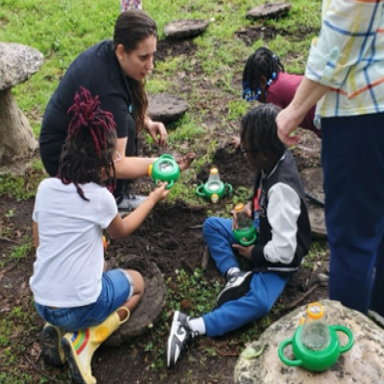(Above: Students exploring nature and science during the Exceptional Science Fair.)
Kalynn Hall Pistorio, Associate Professor of Special Education/ Program Coordinator, Columbus State University
Mary Beth Hendricks, Professor of Special Education, Columbus State University
Whitney Van Gundy, Special Education- Moderate Intellectual Disability Teacher, Gentian Elementary
Four years ago, Dr. Pistorio judged the local science fair. It showcased the top students in the district, but she noticed there were no projects from students with severe disabilities. While these students may not have been independently able to conduct an experiment at the caliber of their peers, participation in a science fair is an excellent opportunity for all students to discover their love for science, technology, and exploration. Unfortunately, students with disabilities have typically been excluded from participation in STEM-related educational opportunities (Heinrich et al, 2016). With this in mind, Dr. Pistorio sought out a way to get students in self-contained classrooms more engaged in science by offering them a science fair of their own.
This became a reality when she discussed the idea with Dr. Hendricks, and the Exceptional Science Fair was born! For the past three years, the Columbus State University special education program has collaborated with Oxbow Meadows Environmental Center and Muscogee County School District to provide a science fair for students in self-contained classrooms. Each fall self-contained classrooms are invited to complete a science fair project of their choosing. In early spring, preservice teachers develop science exploration stations and judge the science projects completed by each class using a rubric that they develop. Finally, in mid-spring, all of the classes that completed a science project received a free field trip to Oxbow Meadows Environmental Center. While there, the students participate in the exploration stations led by the pre-service teachers, tour the facility including the science project exhibit area, go on an interactive nature walk, complete a science-based art project led by a local artist, attend an animal show, and receive awards specifically tailored to each project.
The teachers have reported that it was a positive experience that increased student access and engagement with science content. One teacher stated, “My students had a blast doing their science fair experiment… They LOVED getting to make their triboard and show what they can do.” While another stated, “I think it helped solidify their love for science even more. We usually don’t get invited to more academic based field trips, so this was not only exciting, but practical.” Another teacher commented, “It has been helpful for my kids to see how science matters and is involved more in their everyday lives. The field trip allows us to connect what we talk about in the classroom to the community, and it is fun seeing how excited they get when they can make the connections.” The preservice teachers also described many benefits of the Exceptional Science Fair. “We were able to do more things involving students and actively reaching them rather than just writing papers and talking about things in class. We were able to apply things that we have learned,” reflected a preservice teacher. Another preservice teacher commented, “I was able to see the impact of the experiments on the students, how greatly it impacted their learning, and how they were given opportunities they were never able to have.”

Students touring Oxbow Meadows Environmental Center and looking at other classes’ experiments.
References
Heinrich, S., Collins, B. C., Knight, V., and Spriggs, A. D. (2016). Embedded simultaneous prompting procedure to teach STEM content to high school students with moderate disabilities in an inclusive setting. Education and Training in Autism and Developmental Disabilities, 51(1), 41-54. https://www.jstor.org/stable/26420363
